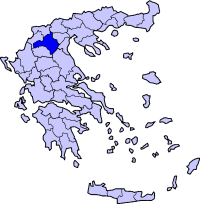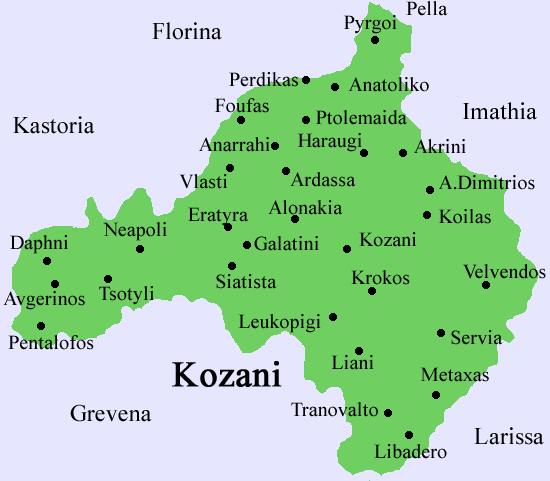Siatista () is a city in the Kozani prefecture, 28 km from Kozani city. The population is c. 5642. It is part of the Siatista municipality , population 6547 (2001) . The first name of the city was Kalivia, because the city was known for its huts. This name is referenced in the archives of the Zavordas Monastery. In 1745, the city was called "Siatista city", as it is referenced in a formal document of Joseph, Patriarch of Ohrid. Siatista was liberated from the Ottoman Turks by the Greek army, on November 4, 1912. The commercial ties between Siatista and many European countries during 17th and 18th centuries were very successful, and allowed the inhabitants to build many mansions and churches with wonderful frescos and icons. About the name of Siatista there are many speculations such as: 1) It is derived from the Vlachic Siat or the Latin Sitis Thirst due to the water problems of the old city 2) It is derived from the Slavic Setsiam, which means divide like the city is divided in Chora and Geraneia 3) From the Turkish Set (fortification) 4) From the German Schatzstadt, Treasury City as it was called by people of Siatista who lived in the German speaking regions
Siatista, Satellite Images, Greece Division of the municipality
Siatista [Source]
"Archontiko" house in Siatista. Celebrations August 15 - Assumption of Mary - The male inhabitants of Siatista parade with their horses down to a chapel in the plane and return with the icon of the Panagia. In the feast and party that ensues the men dance on the backs of the horses. The local wine flows freely, even for their equine friends. December 23 - Κλαδαριές (Klatharies) - On this day the inhabitants gather brush from the surrounding area. Each neighborhood group builds a tall, three to six meters, conical shaped mounds that are decorated sparsely with balloons and tinsel. After nightfall a parade, including a brass band playing local music, begins at the lower town, Γεράνια (Yerania). In succession each mound of brush is set afire as the parade reaches the neighborhood. The inhabitants then dance around the fires. Many of the villages youth then stay up all night around the remnants of the bonfires to start carolling early in the morning of Christmas Eve, collecting money while singing door to door. Persons Thalia Flora Karavia (Θάλεια Φλωρά-Καραβία )
Retrieved from "http://en.wikipedia.org"
 |
|
|||||||||||||||||||





